It’s Not Canon’s Greatest Achievement: Canon EOS M50 II Review
The Canon EOS M50 II doesn’t put the EF-M mount in good light.
Canon saw a great deal of success with the original EOS M50. The camera was snapped up by camera newbies and vloggers who wanted a light camera to tote around. It never wowed us with its image quality, but its versatility was delightful. The APS-C Canon EOS M50 II looks to build on that success, but will a few upgrades here and there make it a worthwhile buy in 2021? Can it compete in this market space? Find out in our full review.
Pros and Cons
Pros
- Small and lightweight
- Good images at lower ISO settings
- Good autofocus in good light
- Eye detect autofocus
- Good battery life
- Works well as a webcam
- Very nice full articulating LCD and EVF for this price point
- Nice menu system
Cons
- No weather sealing
- Tiny buffer (7 RAW – 18 JPEGS)
- RAW files aren’t very pliable
- No stabilization for stills mode, only digital stabilization for video
- Images show noise at low levels
- Above ISO 3200 images are a mess
- Only micro USB and micro HDMI
- Not enough upgrades over the original M50
- $699 with a kit lens is a little high
Too Long, Didn’t Read
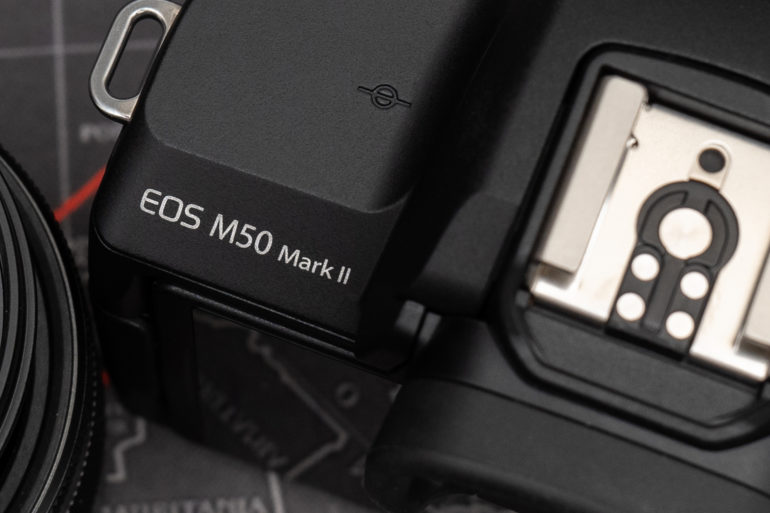
The Canon EOS M50 II is a small APS-C camera that has no real stand-out features. You’ll get decent autofocus and okay image and video quality, but ultimately it lacks features that separate it from the competition. There are better options on the market to choose from for the price ($599 body, $699 with a kit lens). Canon could have made this a killer content-creators’ camera, but they missed the mark and released a mediocre product.
Gear Used
We used the Canon M50 II with the EF-M 15-45mm f3.5-6.3 IS, and the 55-200mm f4.5-6.3 IS.
Technical Specs
All of the technical specs have been taken directly from the official Canon website:
- Recording Media – SD/SDHC/SDXC memory cards
- UHS-I compatible
- Image Format – Approx. 22.3 x 14.9mm (APS-C)
- Compatible Lenses – Canon EF-M lens group
- Image Sensor – CMOS sensor (supporting Dual Pixel CMOS AF) Pixels 24.1 megapixels
- AF Points – Still photo shooting: Up to 143 zones (Maximum)- Video shooting: Up to 117 zones (Maximum)
- 7.4 frames per second in burst mode
- 4K 24p video, 1080p 60, 30 and 24 frames per second
- LCD Monitor – 3-inch touchscreen 1.04 million dots
- EVF – 2.36 million dots
- Dimensions – Approx. 4.58 x 3.47 x 2.31 in
- Weight – 13.65 oz or 0.8lbs with battery and sd card inserted
Canon EOS M50 II – Innovations

Unfortunately, the Canon EOS M50 II doesn’t possess any major innovations. Canon took the M50, updated the autofocus slightly, gave it a clean HDMI out, and stuck a bigger pricetag on it. It can live stream to YouTube via Wi-Fi (I’ll leave it up to you to decide if that’s innovation).
Canon EOS M50 II – Ergonomics
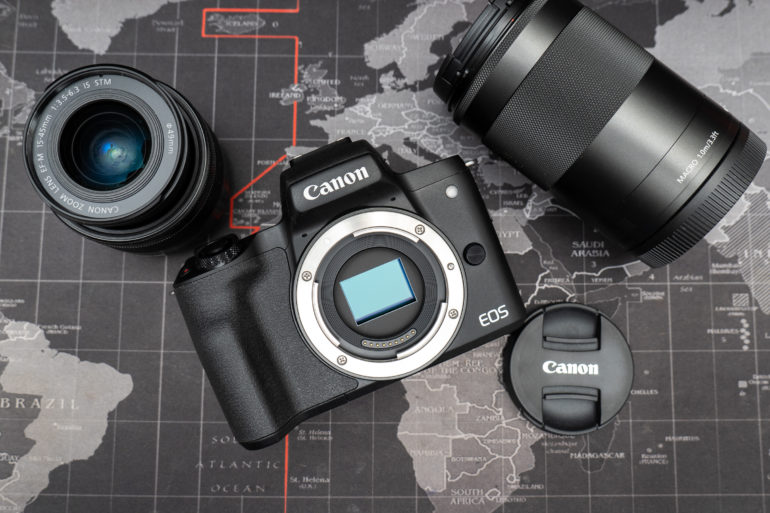
Right off the bat, you’ll see that the Canon EOS M50 II looks almost identical to its predecessor. The controls and dials are in the exact same place, and that’s okay. In the image above, you can see the front of the camera. It’s a nice, clean looking camera. The only thing you’ll notice is the white EOS moniker which stands out against the matte black body. At the top right, there is a focus assist light. The light doesn’t function as a tally light, which is odd as this camera is aimed at vloggers. Next to the lens mount, you’ll find the lens release.
Top Panel
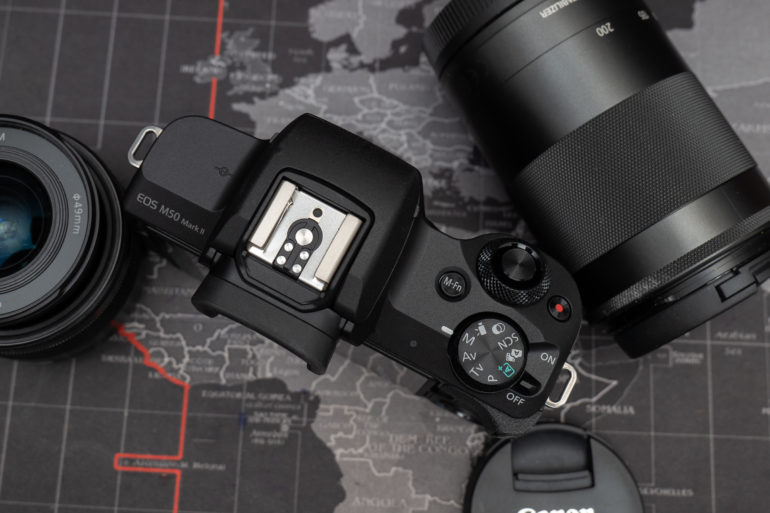
The top of the camera is nicely laid out. The lefthand side of the top panel is completely bare. To the right of the EVF, you’ll find the main mode dial, a function button, a record button, and the dial, which controls shutter speed. Here you can see the size and shape of the grip too. It’s not the deepest grip, but I could hold the camera well, even with my big hands.
Rear Panel
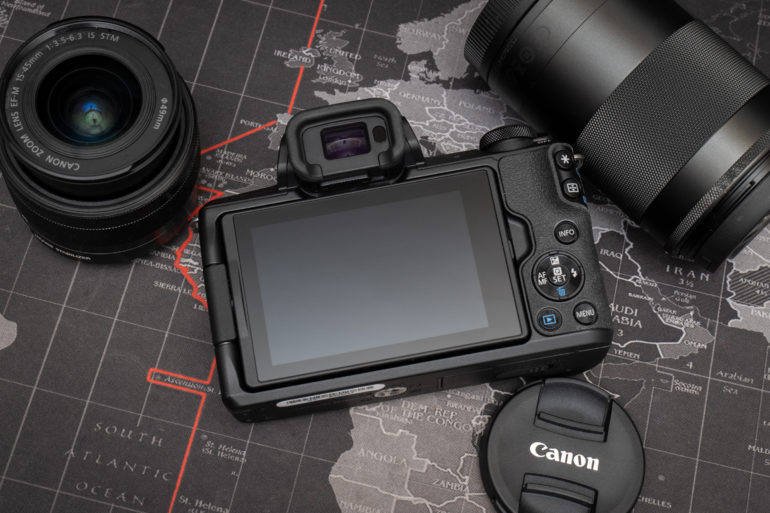
The rear of the camera is dominated by the 3-inch touchscreen. It’s not the biggest screen we’ve seen, but it looks huge as it takes up most of the back. To the right of the screen, you’ll find a d-pad with options to control exposure compensation, manual and autofocus modes, a delete button, and flash control. Beneath that, you’ll see the playback and menu buttons. You’ll see the AE lock button and a button to control your focus point to the top right. There’s no joystick here, and the controls do feel a little cramped. It’s actually a little difficult to use the camera if you have large hands. I often found myself having to hold the camera with both hands to change settings with the physical controls.
Camera Sides
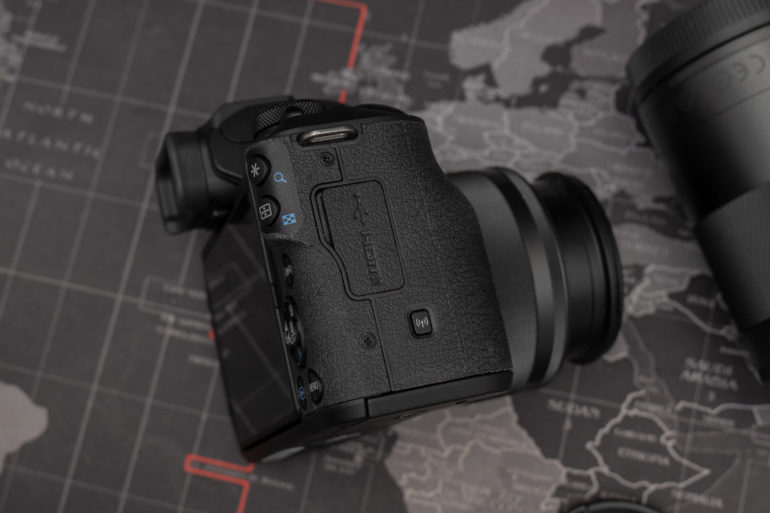
The left-hand side of the camera is home to a single mic input jack. The right side of the camera houses the Micro-USB and Micro HDMI inputs. The SD card lives in the battery compartment on the bottom of the camera.
Overall the Canon EOS M50 II is a camera that screams simplicity. This should come as no surprise as it is aimed at new photographers and videographers. The grip is a decent size for a camera this small, and those with smaller hands should be able to use the M50 II one-handed. It’s light at just 0.8lbs, so you’ll be able to carry this camera around all day with no issues.
“When it comes to the buttons, they provide a nice click when pushed. The LCD and its fully articulating hinge feel solid too.”
Brett Day – Gear Editor
Canon EOS M50 II – Build Quality
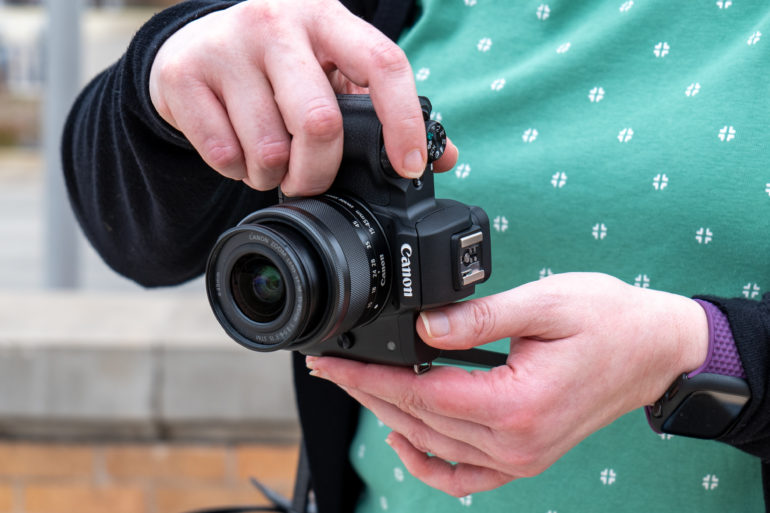
The build quality is what you’d expect to have a sub $600 camera to have. The Canon EOS M50 II is plastic fantastic. This doesn’t mean that it feels cheap or flimsy, but it doesn’t exactly exude class or quality either. The Canon EOS M50 II’s build quality reminds me a lot of the Canon rebel series of cameras. I have abused the fire out of those cameras in the past, and during our review period, the M50 II has stood up to everything I threw at it.
When it comes to the buttons, they provide a nice click when pushed. The LCD and its fully articulating hinge feel solid too. You’re going to have to keep in mind that the Canon EOS M50 II isn’t weather-sealed in any way, shape, or form. So, do not venture out into the rain or snow with this camera. Overall the build quality won’t fill you with joy. However, you can rest at night knowing that it will stand up to the use the average buyer will subject it to.
“The touchscreen will delight those who are coming from smartphones.”
Brett Day – Gear Editor
Canon EOS M50 II – Ease of Use
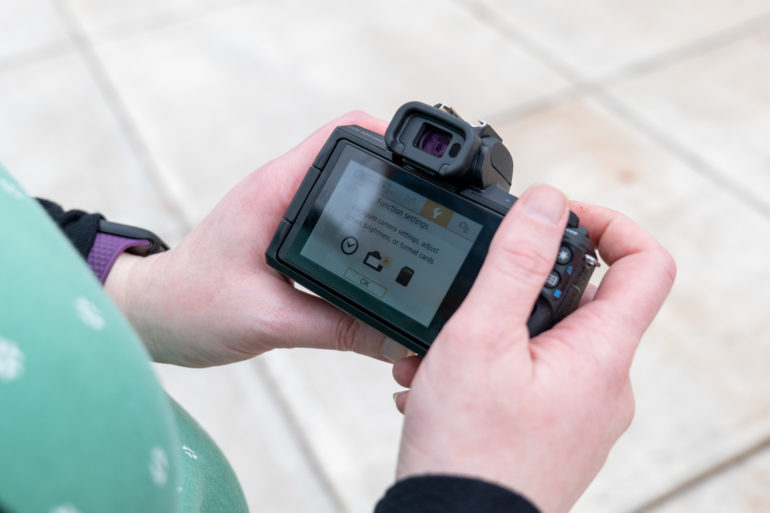
In true Canon form, the EOS M50 II is very easy to use. We’ve come to expect this from Canon cameras. After Hasselblad, Canon has the best menus and user interfaces of any camera manufacturer. The menu system in the Canon EOS M50 II is slightly easier to use than other Canon cameras due to the market it is going after. You’ll find that as you enter the menus, each section has a description that tells you what you can expect to find in the following pages. Another reason this camera is easy to use is the fact that you can touch and swipe through the well-thought-out menus. Newcomers to traditional cameras will not be overwhelmed here.
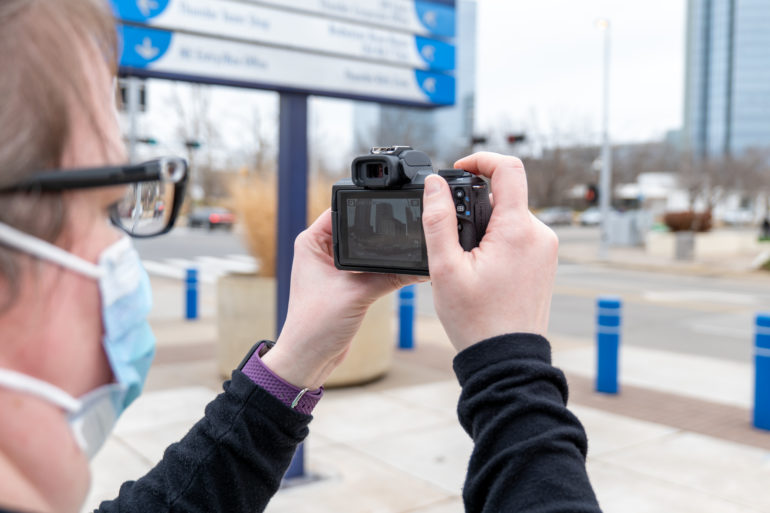
Both the LCD and EVF make the camera easy to use as well. The touchscreen will delight those who are coming from smartphones. The camera is easy to focus thanks to the touch to focus feature. Simply touch the area of the screen where you want the camera to focus. It works like a charm. The LCD is also bright enough to see in sunny daylight conditions as well. Some photographers don’t like fully articulating screens. However, I enjoy them as it makes composing some shots easier. The EVF, while small, gets the job done. When the sun is too bright, you’ll be glad it’s there. It has a resolution of 2.36 million dots, which dwarfs anything from Sony in this price range.
It’s an Easy Camera to Use
As mentioned in the ergonomics section, the controls are well laid out. Due to the size of the camera, those with smaller hands will benefit from the button placements. Those of use with larger mitts will have difficulty adjusting the settings and reaching controls without using both hands. There are some handy scene and filter modes, which will no doubt delight newcomers to traditional cameras as well. Each scene mode has a detailed description of what it is for, as does each filter. For some odd reason, Canon still thinks it’s a good idea to hide the silent shutter mode in one of the scene options. Still, I’m sure these options will be well received by camera newbies.
It Works Well as a Webcam
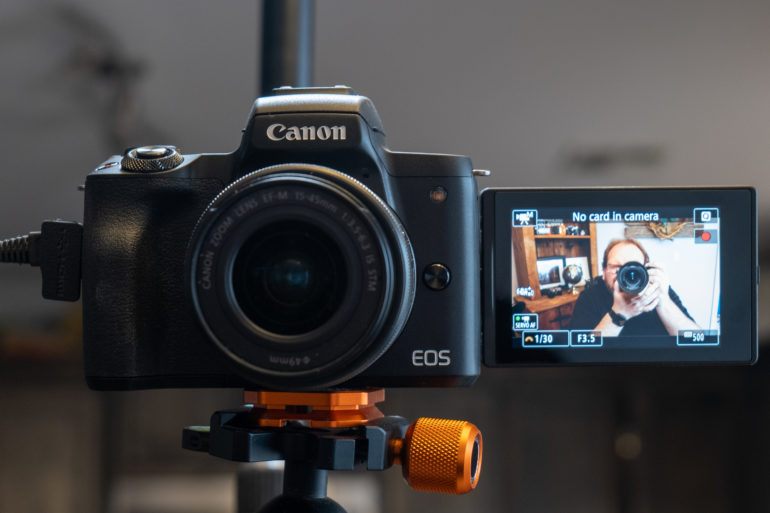
The small size and weight will make this camera ideal for vloggers who like to record themselves while out and about. The flip screen also comes in handy for those who need to use this camera as a webcam. This is also easy to do. Just download the EOS webcam software, attach the camera via USB, adjust your settings for exposure, and you’re done. It works pretty well with just a small amount of lag. Battery life is good. During a day of shooting where I fired off 400 or so shots, battery life was hovering around the 40% mark. Of course, your mileage will vary based on how you use the camera. In terms of the buffer, it’s not great. You can shoot a burst of just 7 RAW files before the camera starts to slow down. You can fire off 18 JPEGS. So, plan your bursts accordingly.
Overall the Canon EOS M50 II is a camera that’s easy to use thanks to great menus and user interfaces. It should be a hit with those who love using touchscreens. It certainly won’t overwhelm new camera owners.
“Compared to other systems on the market in this price range, the Canon EOS M50 II is far behind the competition.”
Brett Day – Gear Editor
Canon EOS M50 II – Autofocus
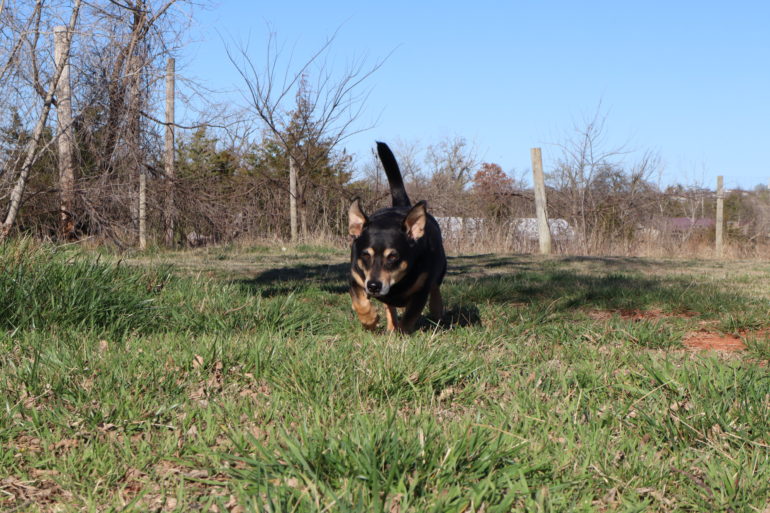
The Canon EOS M50 II features Canon’s Dual Pixel autofocus. This is a focusing system that is a solid performer. However, it’s now showing its age when compared to other focusing systems out there. In great light, the Canon EOS M50 II will find focus and lock on rapidly. This applies to tracking in servo mode and single shot. Eye and face detect also do well, though the camera won’t track an eye with a mask on. That’s pretty par for the course. There is no animal eye af. I noticed the camera had a weird pulsating effect in overcast conditions when trying to find focus. It would eventually settle down and lock on just fine, but I wouldn’t have expected that issue in overcast conditions. In low light, the camera hunts quite a bit more. It did always find focus, but it just took a little bit longer.
Overall the Canon EOS M50 II will be okay for most people who buy this camera. It did always find focus, sometimes with a hiccup along the way. The camera also tracked me well during video recording and webcam usage at 1080p. However, it is worth noting that you will drop to contrast-detect autofocus in 4K. Compared to other systems on the market in this price range, the Canon EOS M50 II is far behind the competition. The Sony a6100, the Fujifilm X-T200, the Nikon Z 50, and the Olympus E-M10 IV, all cameras I have used and reviewed personally, run rings around the Canon EOS M50 II.
Canon EOS M50 II Metering – Sunny 16 Test

For those that don’t know what Sunny 16 is, I’ll cover it briefly here. Sunny 16 dictates that on a clear sunny day, if you have your camera set to f16, whatever ISO you’re using, your shutter speed should be reciprocal. So if you’re at f16 and ISO 200, your shutter speed should be 200. As a result of this, you should have perfect exposure. During our sunny 16 tests, the Canon EOS M50 II was actually very accurate. I saw no major swings in exposure during my time testing the camera. The metering system works well.
“The last Canon camera I used that performed this bad was the Canon EOS 6D II. A camera that had the dynamic range of a piece of toast. This is no better.”
Brett Day – Gear Editor
Canon EOS M50 II – Image Quality

The Canon EOS M50 II offers a mixed bag when it comes to image quality. The RAW files are just okay to work with. However, I would expect most who buy this camera will shoot in JPEG. Here, the camera performs quite well. The colors produced by the camera are natural and not oversaturated, and skin tones look nice. However, I wouldn’t recommend this camera to anyone who needs to do anything but share images on social media. Nor would I recommend it to anyone who needs to shoot in low light. Let’s break it down further.
RAW File Versatility
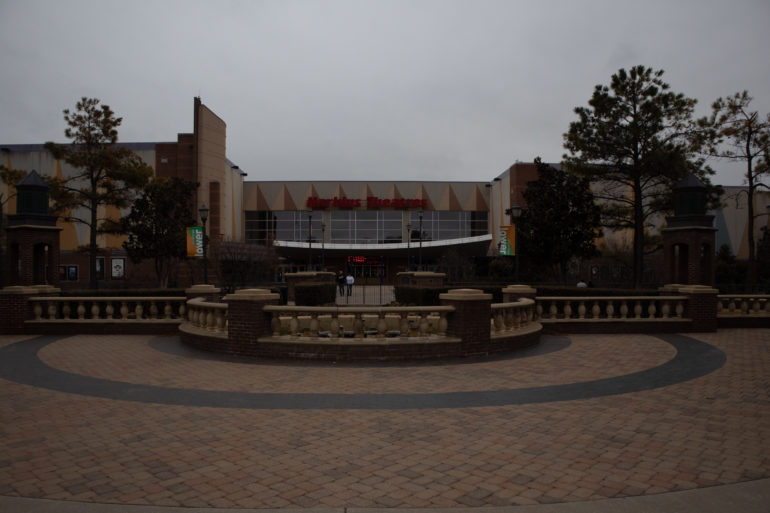
The Canon EOS M50 II produces RAW files that will leave a lot to the imagination, I’m afraid. This is especially true if you shoot at high ISO settings. You can recover a decent amount of detail in the shadows, but you’re going to want to be careful. The last Canon camera I used that performed this bad like this was the Canon EOS 6D II. A camera that had the dynamic range of a piece of toast. This is no better. I’m honestly not sure what Canon has done with this sensor and image processor. I can’t say it’s great, though. Above is an underexposed image. This was done on purpose to see what we could get out of it during editing.

Here is the same image after editing. A fair amount of detail was resurrected in the shadows. However, if you push just a little too far, noise becomes a big issue.

Here is the same scene as above but overexposed. The plan is to try and tame the blown-out highlights during editing.

Above is the edited image. You can see that not much detail was able to be saved in the highlights. It’s definitely best to underexpose slightly and boost the shadows with this camera. For a camera with a modern 24MP sensor, the performance is disappointing. Again, other cameras in this price range easily outperform the Canon EOS M50 II.
JPEG Quality

Somewhat of a saving grace for the M50 II. The JPEGS that that camera produces are good enough for the target audience of this camera. The colors and tones are natural. Provided you keep the camera at low ISOs, the M50 II’s processor does a good job keeping the files looking clean-ish. Though, just like with the RAW files, it has trouble bringing back details in the highlights.

If you’re just using the M50 II to snap images that will just be posted to social media sites, you’ll be okay. If your plan is to print images, I suggest you move on. Again, other cameras in this price range outperform the M50 II. In fact, I called the X-T200 from Fujifilm the best entry-level JPEG camera, and I stand by that statement.
High ISO
 ISO 3200
ISO 3200
Oh, dear. Where do I begin with this? The Canon EOS M50 II struggles in low-light situations. Perhaps more than any other camera I have tested during my three years with The Phoblographer. Noise starts rearing its head at just ISO 400, and by 1600 you’ve pretty much reached what I would call acceptable limits. ISO 3200 can be used in a pinch. At 6400 ISO, tears will run down your cheeks uncontrollably. Even more so if you print the images out, which I did, using the excellent Epson Surecolor P900 (read our review here). I felt bad for using the ink on it.
 ISO 400
ISO 400 ISO 6400
ISO 6400 ISO 6400
ISO 6400
Canon EOS M50 II – Extra Image Samples











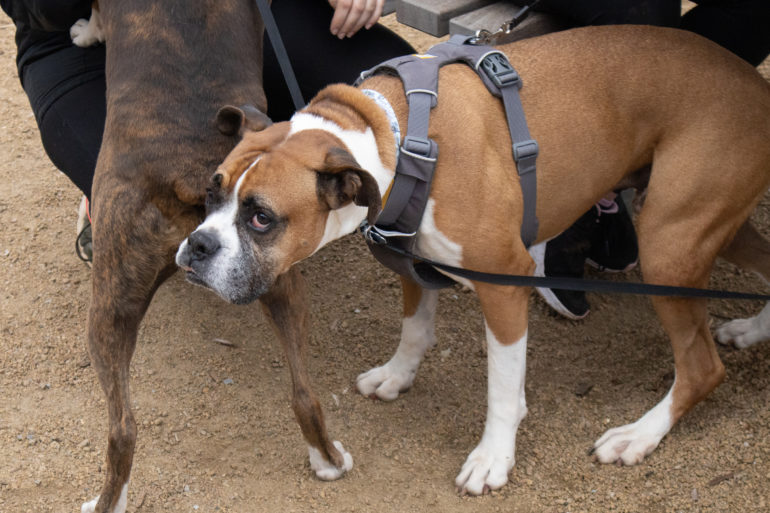





“I have to say that this camera is not worth the purchase if you’re looking at it purely from a stills perspective.”
Brett Day – Gear Editor
Canon EOS M50 II – Conclusions
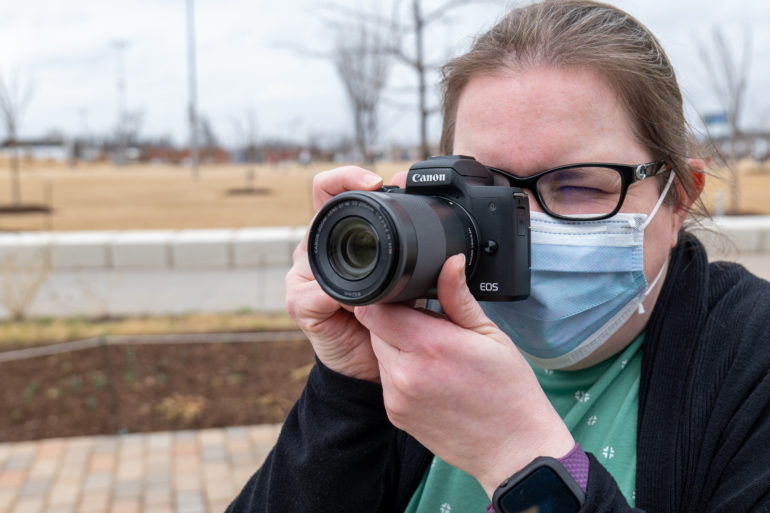
Likes
- Small and easy to use
- Nice LCD and EVF
- Great menus and user interfaces
Dislikes
- Overall image quality is disappointing
- No weather sealing
- Bad high ISO performance
If I’m brutally honest, the Canon EOS M50 II is a camera that should not have been released. I understand that the original M50 was a surefire hit with the vlogging and YouTube crowed. I also understand that many buy it because of the price and the brand name associated with it. The M50 II, though, seems like nothing but a money grab. The sensor and image processor remain the same as the first generation. Therefore, image quality is not the best. In fact, it’s disappointing. The autofocus performance has taken a slight bump up, so that’s good. However, it pales in comparison to its APS-C competition. There is now also a clean HDMI out for those that need it. It also will serve you well as a webcam.
There Are Better Options
The biggest positive is the user interface. This camera is incredibly easy to use, and those coming from smartphones will love that. However, I have to say that this camera is not worth the purchase if you’re looking at it purely from a stills perspective. Even if you want to vlog, there are still better options out there. We thought we had seen the end to this side of Canon. However, it appears to be alive and well.

The Canon EOS M50 II scores just three out of five stars. Compared to the competition, the M50 II simply doesn’t deliver. I praise it for its versatility, but it does neither stills nor video very well. Still, if you want a light camera to vlog with, snap some stills with, and use as a webcam, this is a choice for you. The Canon EOS M50 II costs $599 for the body, $699 with the 15-45mm kit lens, and $929.99 with the 15-45mm and 55-200mm lenses. You can find them all over at Amazon.






